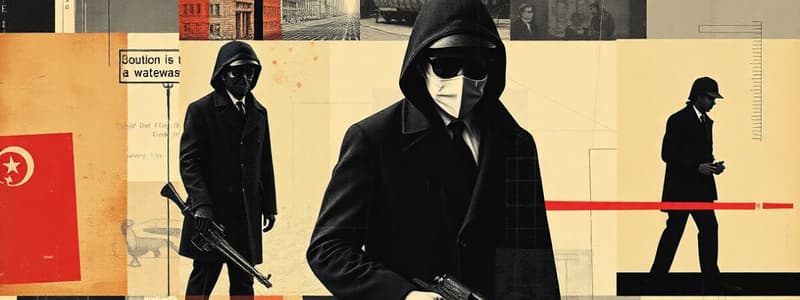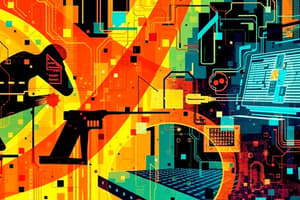Podcast
Questions and Answers
Which act is also known as the Hacking Statute?
Which act is also known as the Hacking Statute?
- Computer Fraud and Abuse Act of 1986 (correct)
- Information Security Act
- Cybercrime Prevention Act
- Digital Privacy Act
The Computer Fraud and Abuse Act of 1986 was originally effective in prosecuting cybercrime.
The Computer Fraud and Abuse Act of 1986 was originally effective in prosecuting cybercrime.
False (B)
Name one famous individual involved in successful prosecutions under the Computer Fraud and Abuse Act.
Name one famous individual involved in successful prosecutions under the Computer Fraud and Abuse Act.
Kevin Mitnick
The Computer Fraud and Abuse Act was expanded to apply to computers used in __________.
The Computer Fraud and Abuse Act was expanded to apply to computers used in __________.
Match the following individuals with their associated cybercrime:
Match the following individuals with their associated cybercrime:
The expansions to the Computer Fraud and Abuse Act focused on which type of intrusions?
The expansions to the Computer Fraud and Abuse Act focused on which type of intrusions?
Title 15 of the supplemental federal criminal law relates to copyright infringement.
Title 15 of the supplemental federal criminal law relates to copyright infringement.
What was one major flaw of the original Computer Fraud and Abuse Act?
What was one major flaw of the original Computer Fraud and Abuse Act?
What main areas did the National Information Infrastructure Act of 1996 (NIIPA) aim to address?
What main areas did the National Information Infrastructure Act of 1996 (NIIPA) aim to address?
The Child Pornography Protection Act (CPPA) of 1996 included protections for virtual images of children.
The Child Pornography Protection Act (CPPA) of 1996 included protections for virtual images of children.
Name one type of offense that NIIPA expanded to include.
Name one type of offense that NIIPA expanded to include.
The _______________ Act of 1984 was supplanted by the Child Protection & Obscenity Act in 1988.
The _______________ Act of 1984 was supplanted by the Child Protection & Obscenity Act in 1988.
Match the legislation to its associated focus:
Match the legislation to its associated focus:
Which of the following was NOT an area expanded upon by the NIIPA?
Which of the following was NOT an area expanded upon by the NIIPA?
The Supreme Court ruled that child pornography is protected under the First Amendment.
The Supreme Court ruled that child pornography is protected under the First Amendment.
What was the significant outcome of Ashcroft v. Free Speech Coalition concerning the CPPA?
What was the significant outcome of Ashcroft v. Free Speech Coalition concerning the CPPA?
What does the PROTECT Act prohibit regarding pretrial release?
What does the PROTECT Act prohibit regarding pretrial release?
The PROTECT Act ended the statutes of limitation on child abduction and abuse cases.
The PROTECT Act ended the statutes of limitation on child abduction and abuse cases.
What mandatory penalty does the PROTECT Act impose on repeat child sex offenders?
What mandatory penalty does the PROTECT Act impose on repeat child sex offenders?
The PROTECT Act provides for electronic ____________ in cases of child abuse or kidnapping.
The PROTECT Act provides for electronic ____________ in cases of child abuse or kidnapping.
Match the following provisions of the PROTECT Act with their descriptions:
Match the following provisions of the PROTECT Act with their descriptions:
Which of the following is NOT a provision of the PROTECT Act?
Which of the following is NOT a provision of the PROTECT Act?
The PROTECT Act authorizes fines and imprisonment for U.S. citizens engaging in illicit sexual conduct abroad.
The PROTECT Act authorizes fines and imprisonment for U.S. citizens engaging in illicit sexual conduct abroad.
What is the application of the Miller standard of obscenity in the Act?
What is the application of the Miller standard of obscenity in the Act?
What is unlawful under the Identity Theft and Assumption Deterrence Act of 1998?
What is unlawful under the Identity Theft and Assumption Deterrence Act of 1998?
The Identity Theft and Assumption Deterrence Act of 1998 only applies to financial information.
The Identity Theft and Assumption Deterrence Act of 1998 only applies to financial information.
What organization was designated as the repository for consumer complaints under ITADA?
What organization was designated as the repository for consumer complaints under ITADA?
The Identity Theft and Assumption Deterrence Act of 1998 includes personal information such as a person's __________ number.
The Identity Theft and Assumption Deterrence Act of 1998 includes personal information such as a person's __________ number.
Which of the following is NOT considered identifying information under ITADA?
Which of the following is NOT considered identifying information under ITADA?
Victims of identity theft can claim restitution for lost time from work.
Victims of identity theft can claim restitution for lost time from work.
Identify one type of unique biometric data mentioned in the ITADA.
Identify one type of unique biometric data mentioned in the ITADA.
Match the following types of identifying information with their descriptions:
Match the following types of identifying information with their descriptions:
What year was the Identity Theft Penalty Enhancement Act enacted?
What year was the Identity Theft Penalty Enhancement Act enacted?
The Health Insurance Portability & Accountability Act allows healthcare organizations to disclose Social Security numbers freely.
The Health Insurance Portability & Accountability Act allows healthcare organizations to disclose Social Security numbers freely.
What is the main purpose of the President’s Working Group on Unlawful Conduct on the Internet?
What is the main purpose of the President’s Working Group on Unlawful Conduct on the Internet?
The _____ Privacy Protection Act prohibits the use of Social Security numbers from motor vehicle records in unauthorized situations.
The _____ Privacy Protection Act prohibits the use of Social Security numbers from motor vehicle records in unauthorized situations.
Match the statute with its main consequence:
Match the statute with its main consequence:
What is one of the main goals of collaboration among business, government, and advocacy organizations regarding Internet crime?
What is one of the main goals of collaboration among business, government, and advocacy organizations regarding Internet crime?
The regulation of Internet criminal activity is treated differently compared to traditional criminal law.
The regulation of Internet criminal activity is treated differently compared to traditional criminal law.
What type of training and cooperation is recognized as a necessary approach for investigating Internet crimes?
What type of training and cooperation is recognized as a necessary approach for investigating Internet crimes?
What was the primary purpose of the National Infrastructure Protection Center (NIPC) established under Presidential Decision Directive 63?
What was the primary purpose of the National Infrastructure Protection Center (NIPC) established under Presidential Decision Directive 63?
The Innocent Images initiative was designed to prevent adults from engaging in interstate travel to meet minors.
The Innocent Images initiative was designed to prevent adults from engaging in interstate travel to meet minors.
What software suite includes tools like Carnivore and Packetier for packet sniffing?
What software suite includes tools like Carnivore and Packetier for packet sniffing?
The method of analyzing large data sets using statistical models and algorithms is known as ______.
The method of analyzing large data sets using statistical models and algorithms is known as ______.
Match the following data mining projects to their descriptions:
Match the following data mining projects to their descriptions:
Which tool was specifically mentioned as a key logger used in the Cyber Knight project?
Which tool was specifically mentioned as a key logger used in the Cyber Knight project?
Data mining can only classify new patterns but cannot predict future activities.
Data mining can only classify new patterns but cannot predict future activities.
Name one example of a data mining initiative used to identify potential terrorists.
Name one example of a data mining initiative used to identify potential terrorists.
Flashcards
Computer Fraud and Abuse Act (CFAA) of 1986
Computer Fraud and Abuse Act (CFAA) of 1986
A U.S. law that criminalizes unauthorized access to computers. Initially focused on financial data and government systems, but later expanded to cover commercial and communication computers.
Original CFAA (1986)
Original CFAA (1986)
The initial version of the Computer Fraud and Abuse Act, considered ineffective due to vagueness and overemphasis on access to financial and government data.
Expanded CFAA
Expanded CFAA
The later version of the Computer Fraud and Abuse Act, broadened the law to cover breaches of commercial and communication computers, along with all financial records.
Kevin Mitnick
Kevin Mitnick
Signup and view all the flashcards
Shadowhawk
Shadowhawk
Signup and view all the flashcards
Robert Morris
Robert Morris
Signup and view all the flashcards
Cybercrime
Cybercrime
Signup and view all the flashcards
Computer Forensics
Computer Forensics
Signup and view all the flashcards
NIIPA (1996)
NIIPA (1996)
Signup and view all the flashcards
Expanded Computer Crime Laws
Expanded Computer Crime Laws
Signup and view all the flashcards
Child Pornography Laws
Child Pornography Laws
Signup and view all the flashcards
New York v. Ferber (1982)
New York v. Ferber (1982)
Signup and view all the flashcards
Child Protection Act (1984)
Child Protection Act (1984)
Signup and view all the flashcards
Child Protection & Obscenity Act (1988)
Child Protection & Obscenity Act (1988)
Signup and view all the flashcards
Child Pornography Protection Act (CPPA) (1996)
Child Pornography Protection Act (CPPA) (1996)
Signup and view all the flashcards
Ashcroft v....
Ashcroft v....
Signup and view all the flashcards
PROTECT Act
PROTECT Act
Signup and view all the flashcards
Mandatory life penalty
Mandatory life penalty
Signup and view all the flashcards
Background checks
Background checks
Signup and view all the flashcards
Electronic eavesdropping
Electronic eavesdropping
Signup and view all the flashcards
Pretrial release
Pretrial release
Signup and view all the flashcards
Statute of limitations
Statute of limitations
Signup and view all the flashcards
Computer-generated child porn
Computer-generated child porn
Signup and view all the flashcards
Miller standard of obscenity
Miller standard of obscenity
Signup and view all the flashcards
ITADA (Identity Theft and Assumption Deterrence Act)
ITADA (Identity Theft and Assumption Deterrence Act)
Signup and view all the flashcards
Identifying information
Identifying information
Signup and view all the flashcards
Biometric data
Biometric data
Signup and view all the flashcards
Electronic identification numbers
Electronic identification numbers
Signup and view all the flashcards
Criminal intent (ITADA)
Criminal intent (ITADA)
Signup and view all the flashcards
Unlawful transfer
Unlawful transfer
Signup and view all the flashcards
FTC (Federal Trade Commission)
FTC (Federal Trade Commission)
Signup and view all the flashcards
Restitution
Restitution
Signup and view all the flashcards
Identity Theft Penalty Enhancement Act of 2004
Identity Theft Penalty Enhancement Act of 2004
Signup and view all the flashcards
Identity Theft Enforcement and Restitution Act of 2008
Identity Theft Enforcement and Restitution Act of 2008
Signup and view all the flashcards
Drivers Privacy Protection Act
Drivers Privacy Protection Act
Signup and view all the flashcards
Health Insurance Portability & Accountability Act (HIPAA)
Health Insurance Portability & Accountability Act (HIPAA)
Signup and view all the flashcards
President’s Working Group on Unlawful Conduct on the Internet
President’s Working Group on Unlawful Conduct on the Internet
Signup and view all the flashcards
Sufficiency of existing internet crime laws
Sufficiency of existing internet crime laws
Signup and view all the flashcards
Cyber crime investigation tools
Cyber crime investigation tools
Signup and view all the flashcards
Cyber ethics curricula development
Cyber ethics curricula development
Signup and view all the flashcards
PDD 63
PDD 63
Signup and view all the flashcards
Infragard
Infragard
Signup and view all the flashcards
Innocent Images Initiative
Innocent Images Initiative
Signup and view all the flashcards
Packet Sniffers
Packet Sniffers
Signup and view all the flashcards
Key Loggers
Key Loggers
Signup and view all the flashcards
Data Mining
Data Mining
Signup and view all the flashcards
Data Mining Applications
Data Mining Applications
Signup and view all the flashcards
Terrorism Information Awareness Program (TIA)
Terrorism Information Awareness Program (TIA)
Signup and view all the flashcards
Study Notes
Computer Forensics and Cyber Crime
- This presentation covers avenues for prosecution and government efforts related to computer crime.
- Learning objectives include understanding traditional laws applied to computer crime, recent federal legislation on online behavior, investigative tools used by the government, and data mining programs.
- The presentation also addresses international attempts to address computer crime.
Introduction
- Law enforcement faces challenges such as smaller agencies with fewer resources, leading to reliance on state and federal agencies.
- Historically, there's been apathy towards nonviolent crime.
- Legislative action on computer crime has moved slowly.
Traditional Statutes
- Primary federal law enforcement provisions related to cybercrime fall under Title 18.
- Examples of crimes covered under Title 18 include fraud, embezzlement, terrorism, espionage, child seduction and exploitation, stalking, kidnapping, forgery, extortion, RICO offenses, access device fraud, and illegal wiretapping.
- Supplemental federal criminal law relating to cybercrime includes Title 15 (credit card fraud and software piracy) and Title 17 (copyright infringement).
The Evolution of Computer-Specific Statutes
- The Computer Fraud and Abuse Act (CFAA) of 1986 initially focused narrowly on unauthorized computer access.
- The act has been expanded to cover computers used in commerce and communication, and now applies to all financial records and intentional intrusions.
- The act was criticized as ineffective, and its initial version was too vague and emphasized access to financial information and government computers.
- Subsequent prosecutions under the CFAA included Kevin Mitnick (program theft), Shadowhawk (breaking into the U.S. Missile Command), and Robert Morris (inventor of the Morris Worm).
- The National Information Infrastructure Act (NIIPA) of 1996 addressed loopholes in the CFAA, broadening the scope to include instances of accidental intrusions and offenses where computer data is not the primary target.
- NIIPA also covered the use of computers in all circumstances and non-commercial settings.
- The act further extended to include transmitting classified government information, obtaining information from financial institutions, private sector computers, and the U.S. government affecting government.
Evolving Child Pornography Statutes
- Efforts at banning child pornography include piecemeal legislation (like the Protection of Children against Sexual Exploitation Act of 1977) plus Supreme Court rulings.
- Cases such as New York v. Ferber (1982) determined that child pornography is not protected by free speech under the First Amendment.
- Later legislation included the Child Protection Act (1984), later supplanted by the Child Protection & Obscenity Act (1988), and the Child Pornography Protection Act (CPPA) of 1996.
- The CPPA covered virtual images, but the Supreme Court's decision in Ashcroft v Free Speech Coalition (2002) deemed it overly broad.
- The PROTECT Act introduced measures like a mandatory life penalty for repeat child sex offenders, criminal history checks for volunteers, and electronic eavesdropping for cases involving child abuse or kidnapping.
Identity Theft and Financial Privacy Statutes
- The Identity Theft and Assumption Deterrence Act (ITADA) of 1998 criminalizes possessing identifying information without authority.
- Identifying information includes social security numbers, dates of birth, driver's licenses, alien registration numbers, passports, and employer/taxpayer identification numbers.
- Unique biometric data (like fingerprints, voice prints, retinas, and irises) and electronic codes are also covered.
- The law also provides restitution, attorney fees, compensation for lost wages, and credit denial penalties.
- The Financial Modernization Act of 1999 introduced the Financial Privacy Rule, which mandated privacy disclosure practices, the Safeguards Rule, requiring security measures in protecting financial data, and addressed pretexting (obtaining personal info under false pretenses).
- The Fair and Accurate Credit Transactions Act (FACTA) of 2003 mandated free credit reports, fraud alerts, truncated credit/debit numbers to deter "dumpster diving", truncated social security numbers, enhanced victim support procedures, and provisions to investigate changes in address for credit cards/accounts.
- Further extensions addressed card issuers investigations, blocking fraudulent info, and consumer reporting requirements.
- Debt collectors are now legally obliged to disclose identity theft and provide info on how to resolve debt issues.
- The Identity Theft Penalty Enhancement Act (2004) mandated sentences for aggravated identity theft, and the Identity Theft Enforcement and Restitution Act (2008) further expanded consequences for such theft.
Additional Efforts to Protect Personal Information
- The Drivers' Privacy Protection Act restricts the use of social security information in motor vehicle records.
- The Health Insurance Portability and Accountability Act (HIPAA) restricts healthcare organizations from releasing social security numbers and health info.
Federally Funded Initiatives and Collaborations
- The President's Working Group on Unlawful Conduct on the Internet involved business, government, and non-profits to evaluate existing laws, technology-specific legislation, and educational resources to minimize the risks of cybercrime.
- Several approaches resulted, including similar regulations to those used in traditional criminal law, recognition of special needs, and cooperation with law enforcement.
- Presidential Decision Directive 63 (PDD 63) and the 'Innocent Images' initiative aimed to bring together law enforcement and private businesses to discuss threats and investigate child abuse.
Law Enforcement Operations and Tools in the United States
- Law enforcement uses tools such as packet sniffers (like Carnivore, Packeteer, and Coolminer), which reconstruct internet communication.
- Key loggers such as the Magic Lantern help record keystrokes and mouse clicks.
- Data mining employs statistical models, algorithms, and artificial intelligence to analyze large datasets to identify patterns like those involved in terrorism (e.g. Terrorism Information Awareness Program, Computer-Assisted Passenger Prescreening System (CAPPS II), Multi-State Anti-Terrorism Information Exchange Pilot Project (MATRIx), Automated Targeting System(ATS), and Terrorist Surveillance Program).
Collaborations and Professional Associations
- Interagency task forces, cyber science laboratories like the one based at the New York Electronic Crimes Task Force, and professional associations (like the High Tech Computer Investigators Association) were created for knowledge sharing and training.
International Efforts
- International collaborations (e.g. OECD, Council of Europe, Interpol) aim to harmonize criminal laws and cooperate for combating computer-related crimes like the alteration of computer data, computer espionage and unauthorized computer use.
- The UN Convention against Transnational Organized Crime (UNCATOC) identified specific cybercrimes needing global attention.
- The Virtual Global Task Force (VGT) combined high-tech security forces from several countries to address child exploitation.
- The Association of Southeast Asian Nations (ASEAN) have shown an interest in training, criminal legislation, and collaboration internationally.
Conclusions
- Recognition of computer-related problems is rapidly increasing, but there's still much needed work.
- Existing laws are used for handling computer-related crime, pending the formation of legislation specific to technology.
- International cooperation is improving, but sovereignty issues hinder progress.
Studying That Suits You
Use AI to generate personalized quizzes and flashcards to suit your learning preferences.




